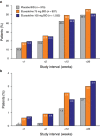Safety of Eluxadoline in Patients with Irritable Bowel Syndrome with Diarrhea
- PMID: 27922029
- PMCID: PMC5318664
- DOI: 10.1038/ajg.2016.542
Safety of Eluxadoline in Patients with Irritable Bowel Syndrome with Diarrhea
Abstract
Objectives: Eluxadoline is a mixed μ-opioid receptor (OR) and κ-OR agonist and δ-OR antagonist, approved for the treatment of irritable bowel syndrome with diarrhea (IBS-D). This analysis evaluated the safety and tolerability of eluxadoline 75 and 100 mg twice daily (BID) in one Phase 2 (IBS-2001) and two Phase 3 (IBS-3001 and IBS-3002) studies.
Methods: Adults with IBS-D (Rome III criteria) were randomized to placebo or eluxadoline (75 or 100 mg) BID for 12 (IBS-2001), 26 (IBS-3002), or 52 (IBS-3001) weeks. Safety data were pooled. Adverse events (AEs) were assessed, with special focus on opioid-related AEs, including suspected sphincter of Oddi spasm (SOS) events.
Results: 2,776 patients were included in the enrolled set; the safety set comprised 2,814 patients, based on actual treatments received. The most frequent AEs in the placebo and eluxadoline 75 and 100 mg groups were constipation (2.5, 7.4, and 8.1%, respectively) and nausea (5.0, 8.1, and 7.1%, respectively); discontinuation due to constipation was uncommon (0.3, 1.1, and 1.5%, respectively). Ten SOS events (10/1,839; 0.5%) occurred in eluxadoline-treated patients, manifesting as acute abdominal pain with elevated aminotransferases or lipase, or pancreatitis; all occurred in patients without a gallbladder. Eight of these events occurred with the higher dose of eluxadoline, within 1 week of initiation of therapy, and all resolved with eluxadoline discontinuation. There were five events independently adjudicated as pancreatitis not associated with SOS, three of which were associated with heavy alcohol use.
Conclusions: Eluxadoline was well tolerated in Phase 2 and 3 trials, with constipation and nausea the most common AEs. Consistent with the known adverse effects of opioid agonists, clinically apparent SOS events were observed in eluxadoline-treated patients. All occurred in patients without a gallbladder and the majority were observed in patients on the higher dose of eluxadoline, suggesting a possible association.
Conflict of interest statement
Figures


Comment in
-
Response to Croteau and Barkin.Am J Gastroenterol. 2017 Oct;112(10):1617. doi: 10.1038/ajg.2017.256. Am J Gastroenterol. 2017. PMID: 28978962 No abstract available.
-
Safety of Eluxadoline in Patients With Irritable Bowel Syndrome.Am J Gastroenterol. 2017 Oct;112(10):1616. doi: 10.1038/ajg.2017.249. Am J Gastroenterol. 2017. PMID: 28978966 No abstract available.
-
Safety of Eluxadoline Use.Am J Gastroenterol. 2019 Jul;114(7):1176-1177. doi: 10.14309/ajg.0000000000000205. Am J Gastroenterol. 2019. PMID: 30920418 No abstract available.
-
Response to Lai.Am J Gastroenterol. 2019 Jul;114(7):1177-1178. doi: 10.14309/ajg.0000000000000312. Am J Gastroenterol. 2019. PMID: 31205133 No abstract available.
References
-
- Chey WD, Kurlander J, Eswaran S. Irritable bowel syndrome: a clinical review. JAMA 2015;313:949–958. - PubMed
-
- Lovell RM, Ford AC. Global prevalence of and risk factors for irritable bowel syndrome: a meta-analysis. Clin Gastroenterol Hepatol 2012;10:712–721. - PubMed
-
- Quigley EM, Abdel-Hamid H, Barbara G et al. A global perspective on irritable bowel syndrome: a consensus statement of the World Gastroenterology Organisation Summit Task Force on irritable bowel syndrome. J Clin Gastroenterol 2012;46:356–366. - PubMed
Publication types
MeSH terms
Substances
LinkOut - more resources
Full Text Sources
Other Literature Sources
Medical
Research Materials

